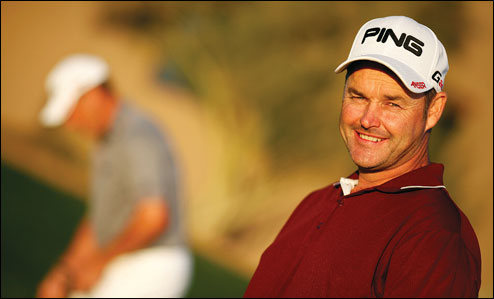Short of playing this game for a (lucrative) living there can be few jobs more satisfying than that of a caddie to a world-class player; a box-seat from which to witness great golf and a globe-trotting itinerary to some truly breathtaking destinations where you are treated, increasingly, to the same levels of hospitality as your boss.
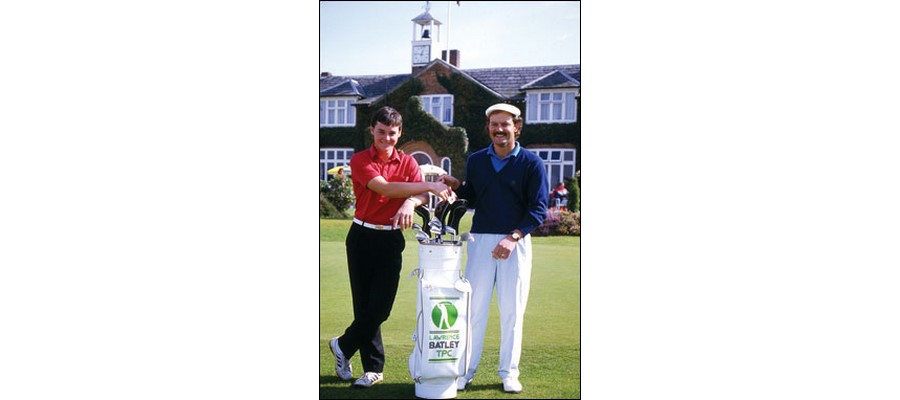
Billy Foster has enjoyed this existence for 30 years and his CV is second to none: after a spell with the South African Hugh Baiocchi he found himself in the company of Gordon Brand Jnr, with whom he experienced his first taste of the Ryder Cup. Next up was Seve, a player Foster idolised as a boy and the man he credits today for making him the caddie he is.
The list goes on: Thomas Bjorn (and the heartache at Royal St George’s in 2003), Sergio Garcia, an emotional ride with Darren Clarke and, ultimately, a relationship with Lee Westwood that appears set to last for quite some time yet, the two men as close off the course as they are a formidable team on it.
Here, to mark his 30 years on tour, Billy talks to Carolyn Nicoll about the life of a bag man.
What is your very first golfing memory?
My Dad would take my older brother and me to Branshaw Golf Club in Keighley, West Yorkshire, near where I grew up. I was about 8 years old and Dad promised that if one of us made a par that he’d buy us pop and crisps. We only had two clubs between us – I had a 7-iron and my brother a 5-iron. One of us made a par, I’m not sure who, but we got our pop and crisps.
How did you get into caddying?
It all began in 1982 at Bingley St Ives Golf Club in Bradford. There was a European Tour event and players asked if any of the juniors would like to caddie. I volunteered and really enjoyed it. I went on to caddie at a few other events in York, Leeds and London and the following year a friend of mine suggested heading over to Spain on a six-week holiday to see if we could pick up a bag at a few tournaments. That was where my career took off, as I worked with several good players, including Tony Johnstone and Mats Lanner. Towards the end of the trip, South Africa’s Hugh Baiocchi asked if I’d come back the following season and work for him. At the time I was an apprentice joiner for my Dad, earning £25 a week – and getting sacked at least twice a week! So I decided to give it a go. I worked with Baiocchi from 1984-’86 – he made it into Europe’s top 20 – and then for five
years with Gordon Brand Jnr. That was pretty special, as it gave me my first taste of Ryder Cup golf.
You were on the bag for Europe’s historic 1987 victory at Muirfield Village?
Yes, that was some induction. Right there, in Jack Nicklaus’s backyard, Europe won the cup for the first time on American soil. The European team included the ‘Big Five’ of Seve Ballesteros, Nick Faldo, Sandy Lyle, Bernhard Langer and Ian Woosnam. Tony Jacklin was the captain and Seve sank the winning putt. It was magical. I also caddied at The Belfry in ’89. That was more disappointing, as we managed to let slip a winning position. The match ended up tied – only the second stalemate in the history of the matches. A week later I was offered the job as assistant at Ilkley, in Yorkshire, and I would have taken it had Seve not asked me to work for him. That was an invitation you couldn’t turn down.
How did the opportunity with Seve come about?
I was with Gordon [Brand Jnr] on what I’d planned was to be my second-to-last tournament and we were drawn to play with Seve for the first two days in Stuttgart. Halfway through the round I was aware of footsteps behind me – Seve tapped me on the shoulder and said ‘What are your plans for next year?’. I explained about the job at Ilkley and he said ‘No, no! You’re too young to retire’. Which was Seve’s way of inviting me to work with him. There wasn’t much of a decision to make. The next day I gave him my business card and told him that if he wanted to bring me out of retirement he knew where to find me! About a month later I received a letter from Seve offering me the job. He explained that he’d been watching me and liked my attitude. Then he listed his conditions – so he built me up and then put me right back in my place, basically saying if you want to caddie for me, this is what I expect from you.
How did it feel, your first tournament together?
We were playing Doral, in Miami. Naturally I was apprehensive. Seve was the greatest golfer of his generation and he just had this aura about him. You could feel it the moment you met him. It was a great honour for me to be there as his caddie and I was humbled when I saw him walking towards me. He held out his hand to shake mine, which was a very special moment. I’d been watching the Open since 1975 – I’d go with my family – and I’d grown up idolising these top players. To achieve a goal of working alongside one of the world’s most famous golfers was fantastic for me, just an incredible experience.
In fact, that first outing was not a tournament but an exhibition match with Jack Nicklaus, Greg Norman and Raymond Floyd, who was a touring pro at Dural. There must have been at least 15,000 people following us – and the golf was something of a shock, to say the least. Seve played like me. I couldn’t actually believe how poorly he hit the ball. He missed the cut in the tournament proper and the following few weeks were not good. I started to think that if I gave myself a couple of weeks practice I could give him a good game! I couldn’t believe it. I’d waited all those years for this chance of a top job with the person I’d perceived to be the world’s best, yet it seemed that he was finished with the game.
But that was Seve in those days. He went through massive peaks and troughs. Just six weeks after I started working for him he went on to win three tournaments in four weeks and he was the best player in the world again. It was such a rollercoaster ride with Seve, but no matter what, he always had this incredible aura about him.
From a caddie’s perspective, can you put your finger on what it was that made Seve so special?
Sheer determination and character. Seve had a ‘never say die’ attitude. He would have walked over broken glass to shoot 79, not 80. Eighty he considered a humbling number in golf. Seve had real pride and the game meant so much to him. Seve always had a totally professional approach to get the very best that he could get out of his day. That attitude and determination stays with me. It was in his course management, the vision he had for certain shots. Today, while I might not be able to play the shots myself, I can stand at the side of whoever I’m caddying for and ‘see’ the right shots, even from what might appear an impossible situation. That’s all down to Seve.

Describe the scene that unfolded on the final hole at the European Masters at Crans-sur-Sierre in 1993, when Seve managed the ‘impossible’ shot.
Simply the best shot I’ve ever seen. Seve had birdied five holes in a row before he stood on the 18th tee and he was tied for the lead. He slashed his tee shot into the middle of some pine trees and finished behind an eight-foot wall. He had half a backswing – a tree was in the way. I saw him on his hands and knees looking at this tiny gap, the size of a dinner plate, 10 yards in front of him. Bear in mind his ball was only a couple of yards from the wall. Seve had about 140 yards to the green and I begged him to chip it out sideways – he could get up and down for a par and still win the tournament. He brushed his hand at me: “No, Billy, I have this shot”. Eventually, in frustration I said to him, look I know you’re Seve Ballesteros but you’re not ****ing Paul Daniels, just
chip it out will you!?”, but he wouldn’t listen and again brushed me away: “No, I have this shot you son of my bitch!”. All I could think about was my percentage of the winnings dwindling by the second!
Anyway, he got down on his haunches and proceeded to play what can only be described as a miracle shot. With half a backswing he hit it over an eight-foot wall with a pitching wedge, through this tiny gap between the pine trees, over the swimming pool, then over some 50 foot conifers, and it landed two or three yards short of the green. Then, for good measure, he chipped it in for a three.
I’m not saying Seve was one of the few professionals who would have played that shot, I’m saying he was the only professional who I’ve come across who’d have taken the shot. It was kamikaze play, ridiculous, just stubborn stupidity. I got down on my knees and bowed to him. People loved Seve because he took on shots like that. That’s what made him special.
As a career move you couldn’t have picked a better player with whom to establish your reputation?
Everything I know as a caddie came from those five years with Seve. Not least, Seve gave me the opportunity to work for him. And that was the greatest endorsement for me.. Other golfers respected the job I did for him. Having that association with one of the game’s greats, well, you’re considered a good caddie – whether I am or not is for other people to determine! It was an amazing experience. Seve and I had good times and bad times together. We were very close, like brothers. To think of him at the end, before he passed away, it broke my heart.
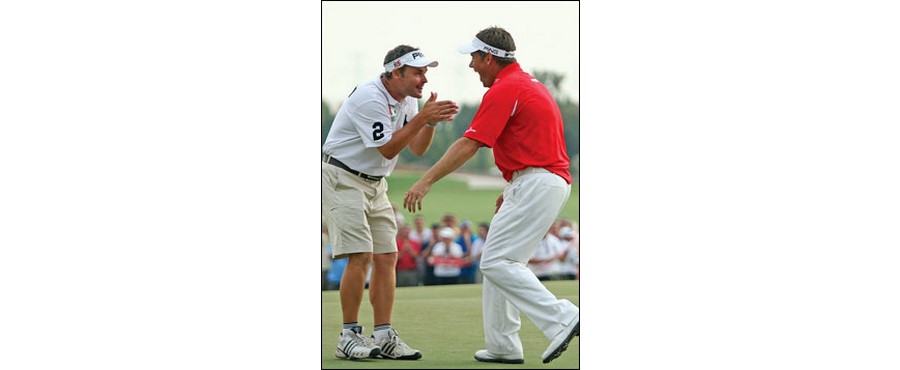
You’ve been with Lee Westwood for three years now – what has been the highlight?
I’m hoping the highlight is still to come! Workingwith Lee is the most enjoyable job I’ve ever had. We get on so well, he’s my best mate. Lee has rededicated himself to the game. He works harder than anyone can possibly imagine and he’s playing some of the best golf he’s ever played right now. A lot of people forget that Lee was up there with the best of the European golfers in the late 1990s and then had a shocking period from 2001-03. He went from No. 4 in the world to 250. So for him to come back and reach the No.1 spot in world golf is an unbelievable achievement. He’s won eight tournaments in the three years that we’ve been together and he’s had a handful of good opportunities to win a major. He keeps knocking on the door and that’s a testament to how consistent he is. The defining moment will be that first major.
How close are you off the course?
We have a great time. We took our families on holiday to Dubai for a week last year and we also enjoyed a mini cruise with our wives out of St Tropez, what a fantastic experience that was – a brilliant place and a bit of a booze cruise! [laughs]. It’s a bit different from a boat trip on the local canal in Yorkshire. I often stop and think just how lucky am I? This really isn’t bad for a lad who was brought up on an estate in Keighley. Lee and I also like to go to big sporting occasions together. We like the football and go to watch Leeds United or Nottingham Forest. If you can call that a big sporting occasion!
What’s the best golf you’ve seen Lee play?
There are two occasions I would nominate, both towards the end of last season. Lee shot 62 at Sun City, in South Africa, and that was probably the best ball striking display I’ve ever seen as a caddie. The best round I’ve seen him play was at Amata Springs, in Thailand, when he shot 60 – and this was over a difficult golf course with 20mph winds blowing. Lee’s on top form at the moment, he’s never been fitter and he’s got that confidence a player needs. If you feel good physically then you’ve got that positive approach.
Who do you rate as the best ball striker you’ve ever worked with?
It’s a toss up between Lee and Sergio Garcia. Lee is unbelievably accurate off the tee, very straight and long. Sergio is great at driving the ball and shapes the ball as well as any current player. His control of ball flight is also second to none. Darren [Clarke] had his moments, too. I’d say Darren’s golf during the 1999 European Open at the K Club in Dublin – when in the second round he shattered the course record by four strokes with a 12-under-par 60 – was sublime.

And you had another momentous week with Darren there in the 2006 Ryder Cup?
Yes. Darren called me to say he’d been offered the wild card – this was just after his wife, Heather, had passed away. He asked me my thoughts. We had a personal discussion and decided that the right thing to do was what Heather would have wanted him to do, and play. The atmosphere through the week brought tears to my eyes on several occasions; the last round was so special, it was basically coming down to Darren to win the Ryder Cup and it was so emotional for him on the 16th when he did. He just burst into tears. That will stay with me forever as my most memorable occasion on a golf course.
If you had your time again would you consider being a professional golfer?
No! Not unless I happened to be 10 shots a round better than I am. There’s an ocean of difference between being a good low handicap amateur and a tour player. Young players don’t understand it; they get to scratch and think they are a good player. But you have to be exceptional to make it as a pro these days. A scratch player is like a 12 handicapper compared to the standard of the top players. The courses are just so much longer, the rough is tougher, there’s water everywhere and the greens are like lightning. I’d have been eating baked beans out of a can for the rest of my life if I’d gone down the pro route.
When Steve Williams went off to be at the birth of his first child, Tiger Woods ‘borrowed you’ from Darren Clarke. What was it like working with Tiger?
Tiger’s the only man that I’ve worked for who has that same aura as Seve. These people are few and far between but I felt it with Tiger. I knew it was going to be a massive challenge but one that I’d relish. It was a very intimidating situation, even though I had all that experience of working with big-name players. I actually struggled to be myself with Tiger over the first few days because I knew just how important it was. Tiger’s the best player of all time. Of course, he may never be considered that until he beats Jack’s [Nicklaus] major record, but for that ten-year period when Tiger was on top, say from 1998-2008, he was untouchable. He’s a special man and it was a pleasure to work for him. One day my kids will look back and say “My Dad caddied for Tiger Woods”.
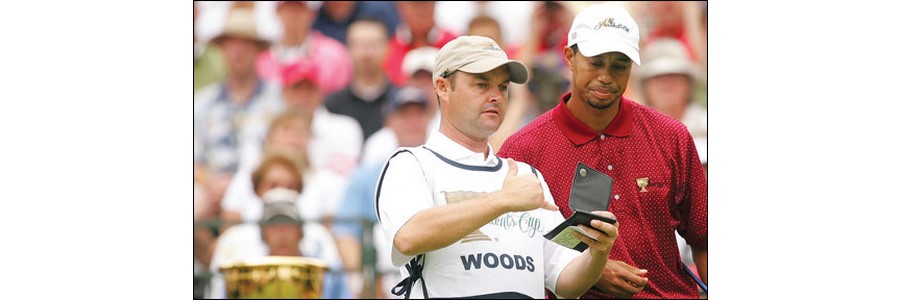
Is the general consensus among the players you are around, and other caddies, that Tiger is the best player of all time?
Yes, I’d say so. For that 10-year period Tiger was the complete package. He drove the ball long, his distance control was incredible, his short game was as good as it gets, his putting was amazing. He just nevermissed putts. I remember asking Steve [Williams] how many putts he could remember Tiger missing on the last green when he needed it to win a major tournament… and he couldn’t remember a single one. His mental strength was unsurpassable. He was the ultimate warrior.
Were you tempted to throw your name into the ring as Tiger’s new caddie?
No, not at all. I’m extremely happy in the job I’m doing with Lee. He’s a top player, he’s my best friend and he’s giving his all to win. Don’t get me wrong, working for Tiger is a job that any caddie would love and I’ve done it for a week. I really like Tiger, we got on well then and we still do. Working for Tiger’s very different, as you are constantly under the spotlight, on and off the course. Even if you pop out for a meal, there’s the Tiger circus that surrounds him. I’m not saying that I wouldn’t want to do it again one day, but I’ve certainly no plans of throwing it all away with Lee, we’re having the best time together and I’m looking forward to what’s to come.
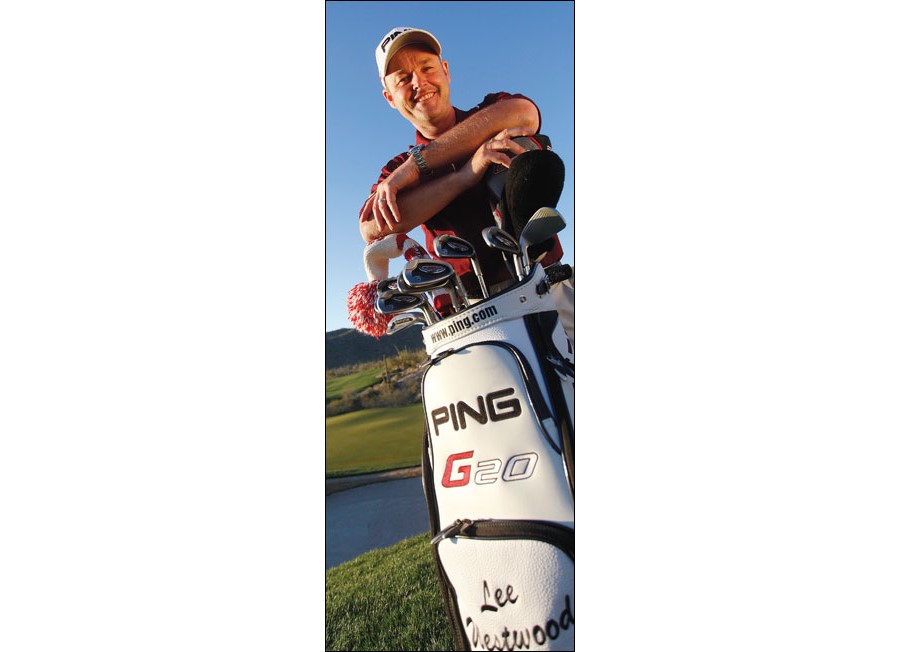
What’s your ultimate goal?
My burning desire is to caddie for the guy who wins the Open Championship. It’s been close on a number of occasions – no more so than with Thomas Bjorn at Royal St George’s in 2003 and to a certain extent with Lee at Turnberry in 2000, when we were all watching Tom Watson. Hopefully it will be this year.
Those closing moments with Thomas at Sandwich must have been tough to endure?
Being on the bag with Thomas when he lost the Open in 2003 was the most painful experience I’ve ever known on a golf course. We stood on the 15th green and he turned to me and said ‘Billy we’re leading this by three’, which was quite a statement to make. I told him there was a lot of hard work to do and that he needed to focus on what he was doing. After leaving his ball in the bunker twice at 16 he made doublebogey and then had another bogey at the 17th. He eventually lost by a shot. I know how tough it was for me – and you can only imagine how he must have felt. I thought about it every day for six months. That’s how much it hurt me.
How often do you actually get to play golf?
I don’t really, just a couple of times a year. Officially I’m still off 4, but I don’t play enough to justify that.
What’s been your lowest handicap?
It was 3, but I’ve caddied more or less full time from the age of 16, so I’ve actually had little time to play golf. That’s one of the few regrets I have – I’ve seen the best players, had some incredible lessons, and I know I could have been a pretty decent player, but I just don’t have the time. I’m on the road with golf for 32 weeks of the year so when I do get back home I want to spend my time with my wife and children. When I’ve been carrying a bag around as part of my job, the last thing I want to do is carry my own golf bag around in my spare time!
Are you still a member at Bingley?
I’ve been a member at Bingley St Ives for 32 years. The 19th hole is actually known as ‘Billy’s Bar’ and is full of golfing memorabilia that I’ve donated. I like to go there on a Saturday teatime when I’m at home. There’s a great set of people at the club and a fantastic atmosphere. It’s the one 19th hole that’s really special to me.
On the rare occasions you do get your clubs out, who would you invite for a dream fourball?
That’s a tough question. Jack Nicholson, for his character. I suppose I’d throw in Tiger in his prime – not that Lee will be happy about that [laughs]. I’ll put Seve in as well. So that’s Tiger and Seve vs. Jack Nicholson and Billy Foster! Oh, and I’ll tell you what, if I had £5 for every time someone has said I look like Jack Nicholson I’d be a multi-millionaire by now. I don’t know why. I think it’s when I put my shades on.
Where would you play this epic match?
We’d play at Royal Dornoch in the Highlands of Scotland, because of its tranquillity and beauty. It’s also a great course. Scotland and Ireland are my favourite destinations – I love links courses.
What’s the best golf gadget on the market today?
As a caddie, it’s got to be the laser. I’ve always done my own yardages, and it wasn’t all that long ago I was still using a yardage wheel, the type you see guys measuring motorways with. And I had a bit of string that I’d pull out of a box. I remember one hole in Sun City in South Africa and I had this yardage string going through snake-infested jungle and then over water to a short par three. It took me over an hour to get a precise number to the centre of the green. Now I’d just walk on the tee, zap the flag and it would tell me – 130 yards precisely. Before the laser it could take me six hours and more to map a course. Now I can have it done in three hours.
Do you keep up to date with all the new golf equipment and gadgets?
Absolutely not. My view on it is if it ain’t broke don’t fix it. Lee gets new stuff thrust at him all the time and my argument is always that you got to be the world No. 1 using the equipment you’ve got, so why change it when you’re playing your best? I’m not big on change; it has to be far superior to even consider it.
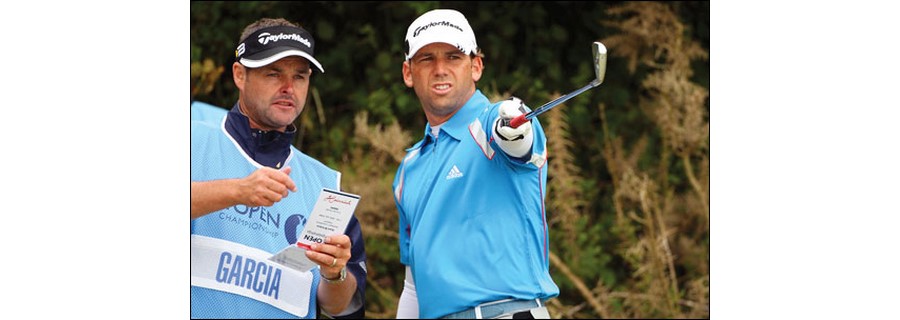
What’s your favourite golf tournament?
There are two. The Open Championship and the Ryder Cup are the best tournaments in the world, by far. The Open is the oldest and most prestigious – as a British person it is the tournament you want to win. The Ryder Cup for the atmosphere. There’s no othertournament with an atmosphere like it.
Talking about the Ryder Cup, which of the most recent captains did most to make the caddies feel a part of the team?
That’s a tough one because they all have their different ways and there are great qualities about all of them. Colin Montgomerie and Mark James were both brilliant because they really did make the caddies feel involved. Some captains have meetings with the players but not always with the caddies, but Monty and Jesse made a point of involving us. They both made it a lot of fun.
How do you think Jose Maria Olazabal will fare as captain?
I think he’ll be the best captain ever and I mean that. He’s got that fantastic passion for the role. His desire and honour are second to none. English may not be his born language, but let me tell you, he’s a better communicator than most of us!
How has the caddie’s lot changed since you started?
Dramatically. It was a tough existence being a caddie in the early days and there were many times when I got to the end of the week and couldn’t afford the bus home (and I mean bus – I rarely flew in those days). In 1983 I caddied for Tony Johnstone in Portugal, he came 7th and won £900. I got 5% of that – £45. My wage was £90 and out of that I had to get to Portugal and pay for the hotel and food. It was hard to make a living back then but it’s a different story today. Not only financially. We are well looked after at tournament venues, the practice ranges have all you could wish for and travel is much easier.
What’s the best route in for anyone interested in becoming a tour caddie?
There is no easy way in. When I started there were relatively few who wanted to do it. Now, with the money in golf there are plenty of candidates. Even ex-players want to become caddies because it enables you to be a part of the tour, to travel the world and make decent money. So it’s difficult, but my advice would be to go to a qualifying school or the Challenge Tour and get a foot in the door that way. Keep your eyes open and follow trends to see who is good on that tour and then hopefully graduate to the main tour with one of the up and coming players. Once you get on the tour, it’s a case of being humble, respect people, dress smart and rock up on time.
What’s been your most lucrative week’s work?
Er, that’s classified! Caddies generally get paid a wage and then a percentage of the player’s winnings. It tends to be 5% but could go up to 10% if you’re with one of the top players and you win a big tournament. When Lee won the Dubai World Championship and the Race to Dubai in 2009 it was a double-whammy with the bonus pool. It was lucrative, but I’m not saying how much!
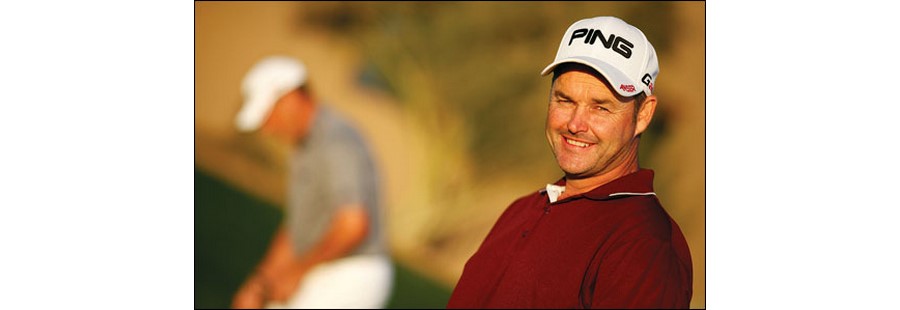
This year you’re celebrating 30 years on tour. Did you ever dream that you’d get to work with such golfing legends – and still be doing it 30 years down the line?
No, not at all. My goal was to set off for a couple of years and maybe see Europe. I wanted to experience the game and learn more as a player myself. Here I am 30 years down the road and I’ve been so fortunate to have had such a great career and caddied for so many fantastic players and been in the company of the greatest players in golf over the last few generations. Along the way I’ve been lucky to have encountered some incredible people and seen some unbelievable places. There are one or two that stick in your mind – the ones you want to have your photo taken with. Bill Clinton was one and of course the amazing Muhammad Ali, who I met at the 2008 Ryder Cup at Valhalla. As a boy I grew up watching this fantastic boxer and sports personality. What can I say, he’s a legend and the great man was voted the greatest sportsperson of the millennium. That says it all.
You’ve made it to the palace, too?
Yes, I met Prince Philip at a royal reception at Buckingham Palace, at an event to meet relatives and wives of soldiers that had been killed. I was invited because I get involved with charities whenever I can and I’ve donated a lot of golf memorabilia and golf gear, signed bags and Ryder Cup prints from some of the top players to help various charities. That’s a really great thing about being in this privileged position – you can give something back. In 2009 I walked the 90 miles from Loch Lomond to Turnberry with the golf bag all the way, and raised £70,000 for the Candlelighters Childhood Cancer Trust and the Darren Clarke Foundation Breast Cancer Charity. It gave me a good feeling to go to the children’s hospice to hand over the £35,000 cheque and to try and help in some way. I’ve just been contacted by the Seve Ballesteros Foundation Cancer Trust. I donated the winning World Matchplay caddie vest, which was the last time Seve won it of his five
matchplays in 1991. It raised £11,000 which was a great effort for his foundation. It really feels like I’m still helping him when he has gone!
What have been the highlights?
I’ve been unbelievably lucky to have such good fun doing my job. Every day I get up and I look forward to going to work. I have my own family, I have my wife Lisa’s family and I have my family from the tour. That’s the way I look at it, so many good people around me, and having a fantastic time. The downside is spending so much time away from family and friends. Missing memorable moments with my son (10) and daughter (9) over the years while they’ve been growing up has been a massively hard thing to stomach at times; not being at their school sports days and family birthdays. It comes with a price but the good far outweighs the bad. I’ve managed to earn a good living for my family, something I never thought we’d have. Here’s me, a Yorkshire lad travelling the world and staying in some unbelievable hotels. The St Regis Hotel in Bangkok was particularly spectacular. Sometimes I get to my room, throw my bags down and have a chuckle to myself, just thinking how good is
this for a lad from Keighley! You know, where did it all go wrong?
Originally posted in 2012
